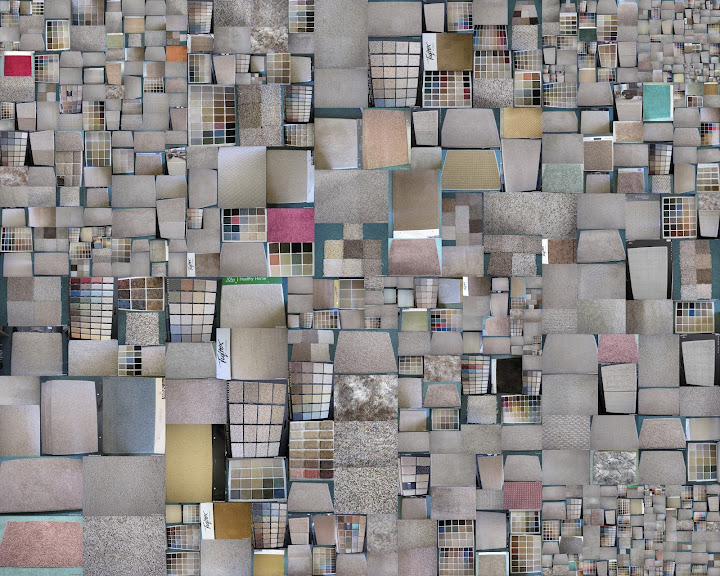” Broadloom absorbs sound, an appealing feature for condominiums, town houses, and homes with high ceilings. Yarn construction and surface texture add soft contrast to a room’s angular architecture. As versatile camouflage, broadloom goes over any existing floor, with no need for a new sub-floor, and it hides uneven surfaces and existing floor damage. Today, carpet is available with soil, stain, odor, and static-resistant features, and manufacturing techniques have increased its durability and clean ability.”
TYPES & STYLES
4 types of carpets
Cut Pile: when the loops are cut
Loop Pile: when the loops remain uncut
Patterned Loop: when the loops remain uncut and the loops have multiple heights
Cut & Loop: when the loops are combined.
CARPET FIBERS
Nylon
Nylon is more expensive than other synthetic carpet fibers and has been the most commonly used carpet fiber since the early 1960’s. In overall performance characteristics, nylon is the most versatile of all fibers, providing excellent flexibility in creating a variety of carpet styles. Nylon can be found in a wide range of both cut pile and loop pile styles. It is durable, resilient, and receptive to dyeing for color versatility and uniformity; many new nylon yarn systems are also exceptionally soft. Though not inherently stain resistant, most nylon carpets are treated with stain-resist carpet treatment for protection against household spills and stains.
Polypropylene (also called Olefin)
Since 1980, the use of polypropylene carpet fibers has grown dramatically. Unlike the other fiber types, polypropylene will not absorb water and must therefore be solution dyed (pigmented) to impart color. Solution dyeing is a pigmentation process in which color is actually built into the fiber when it is formed, or extruded, thereby becoming an inherent part that cannot be removed from the fiber. The color will not fade, even when exposed to intense sunlight, bleaches, atmospheric contaminants, or other harsh chemicals or elements. However, since it is not as resilient as other fibers, poypropylene is normally used in loop pile constructions in which there is less need for superior resiliency.
Polyester
Polyester offers exceptional softness and color clarity, and it is also naturally stain and fade resistant. While polyester is not as inherently resilient as nylon, carpets made of polyester fiber will perform well if appropriately constructed. Carpets of polyester are generally available only in cut pile styles and are usually less expensive than nylon in comparable weights.
Wool
The preeminent natural fiber and used in the manufacture of carpets and rugs longer than any other fiber. In fact, the weaving of wool carpets has been traced back to 3,000 B.C., and wool rugs and carpets have been prized as objects of beauty and prestige ever since. Wool does not have the stain and abrasion resistance of some of the man-made fibers, but it has an enduring quality, and many wool carpets and rugs are said to “age gracefully.” Soft underfoot, wool also offers the somewhat intangible consideration of prestige. However, wool carpets are considerably more expensive than most synthetic carpets and represent less than 1% of all broadloom carpets sold. There’s also fiber blend such as nylon and polypropylene.
Residential Carpet | Commercial Carpet | Indoor & Outdoor
DURING INSTALLATION
Open windows and doors, use an exhaust fan. This will clear the new carpet smell very quickly, usually in less than 72 hours.
Carpet Installation Process:
AFTER INSTALLATION
In the months following installation, you may notice some shedding or sprouting. This is normal and will not affect the carpet’s life or beauty. Here’s what to do:
Shedding— The shedding of loose fibers is normal and should subside with regular vacuuming.
Sprouting— If a single tuft extends beyond the carpet’s surface, simply clip it off. Do not pull it out.
Pile reversal or shading— This seeming color change may occur in various parts of the carpet, caused by light being reflected in different ways as pile fibers are bend in different directions. This is not a defect but a characteristic of plush carpet.
Wrinkling— If ripples occur, do call us immediately. It may be necessary to restretch the carpet.
MAINTENANCE
Clean carpet every 12 to 18 months. Hot water extraction systems provide the most effective cleaning. Professional carpet cleaners generally get the best results. Use Dyson or Kirby vacuum to best remove all allergens for your carpet. Check out this review to decide which vacuum works best for you.





